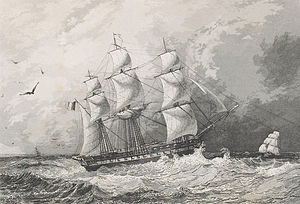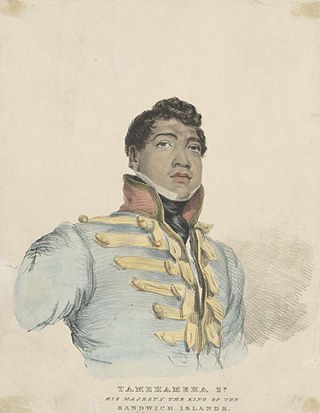
Kamehameha II was the second king of the Kingdom of Hawaii from 1819 to 1824. His birth name was Liholiho and full name was Kalaninui kua Liholiho i ke kapu ʻIolani. It was lengthened to Kalani Kaleiʻaimoku o Kaiwikapu o Laʻamea i Kauikawekiu Ahilapalapa Kealiʻi Kauinamoku o Kahekili Kalaninui i Mamao ʻIolani i Ka Liholiho when he took the throne.
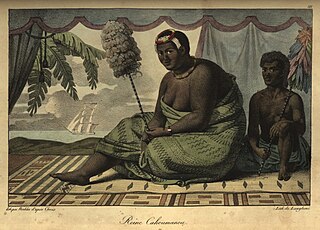
Kaʻahumanu was queen consort and acted as regent of the Kingdom of Hawaiʻi as Kuhina Nui. She was the favorite wife of King Kamehameha I and also the most politically powerful, and continued to wield considerable power as co-ruler in the kingdom during reigns of his first two successors.

The Cathedral Basilica of Our Lady of Peace is the mother church and cathedral of the Diocese of Honolulu.

Kamehameha III was the third king of the Kingdom of Hawaii from 1825 to 1854. His full Hawaiian name is Keaweaweʻula Kīwalaʻō Kauikeaouli Kaleiopapa and then lengthened to Keaweaweʻula Kīwalaʻō Kauikeaouli Kaleiopapa Kalani Waiakua Kalanikau Iokikilo Kīwalaʻō i ke kapu Kamehameha when he ascended the throne.

The Diocese of Honolulu is a Latin Church ecclesiastical territory or diocese of the Catholic Church for the state of Hawaii in the United States. It is a suffragan diocese in the ecclesiastical province of the metropolitan Archdiocese of San Francisco.
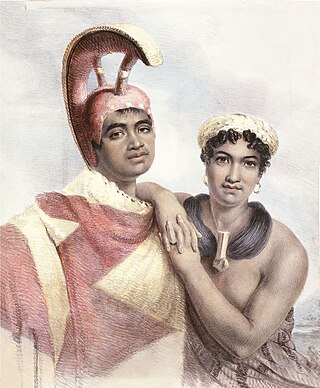
Kuini Liliha was a High Chiefess (aliʻi) and noblewoman who served the Kingdom of Hawaii as royal governor of Oʻahu island. She administered the island from 1829 to 1831 following the death of her husband Boki.

Alexis Bachelot, SS.CC., was a Catholic priest best known for his tenure as the first Prefect Apostolic of the Sandwich Islands. In that role, he led the first permanent Catholic mission to the Kingdom of Hawaii. Bachelot was raised in France, where he attended the Irish College in Paris, and was ordained a priest in 1820. He led the first Catholic mission to Hawaii, arriving in 1827. Although he had expected the approval of then Hawaiian King Kamehameha II, he learned upon arrival that Kamehameha II had died and a new government that was hostile towards Catholic missionaries had been installed. Bachelot, however, was able to convert a small group of Hawaiians and quietly minister to them for four years before being deported in 1831 on the orders of Kaʻahumanu, the Kuhina Nui of Hawaii.
Arsenius Walsh, SS.CC.,, was an Irish Catholic priest who was among the first Roman Catholic missionaries in the Kingdom of Hawaii. He was a member of the Congregation of the Sacred Hearts of Jesus and Mary, a religious institute based in Paris, better known as the "Picpus Fathers", which had been founded during the turmoil of the French Revolution. He is called the Apostle of Hawaii.
Columba Murphy, SS.CC. was French Catholic priest of the Congregation of the Sacred Hearts of Jesus and Mary, a religious institute of the Roman Catholic Church. He helped found the Roman Catholic mission in the Gambier Islands and was one of the first Catholic missionaries to arrive in the Kingdom of Hawaii during the persecution by Kaʻahumanu, Kamehameha III and their American Congregationalist advisors.

Kuhina Nui was a powerful office in the Kingdom of Hawaiʻi from 1819 to 1864. It was usually held by a relative of the king and was the rough equivalent of the 19th-century European office of Prime Minister or sometimes Regent.

Princess Kalani Ahumanu i Kaliko o Iwi Kauhipua o Kīnaʻu, also known as Elizabeth Kīnaʻu was Kuhina Nui of the Kingdom of Hawaiʻi as Kaʻahumanu II, queen regent and dowager queen.

The Catholic Church during the Age of Discovery inaugurated a major effort to spread Christianity in the New World and to convert the indigenous peoples of the Americas and other indigenous peoples. The evangelical effort was a major part of, and a justification for, the military conquests of European powers such as Portugal, Spain, and France. Christian missions to the indigenous peoples ran hand-in-hand with the colonial efforts of Catholic nations. In the Americas and other colonies in Asia, and Africa, most missions were run by religious orders such as the Franciscans, Dominicans, Augustinians, and Jesuits. In Mexico, the early systematic evangelization by mendicants came to be known as the "Spiritual Conquest of Mexico".

William Pitt Kalanimoku or Kalaimoku was a High Chief who functioned similarly to a prime minister of the Hawaiian Kingdom during the reigns of Kamehameha I, Kamehameha II and the beginning of the reign of Kamehameha III. He was called The Iron Cable of Hawaiʻi because of his abilities.

Boki was a High Chief in the ancient Hawaiian tradition and served the Kingdom of Hawaii as royal governor of the island of Oahu. Boki ran a mercantile and shipping business and encouraged the Hawaiians to gather sandalwood for trade.

The Hawaiian Kingdom, or Kingdom of Hawaiʻi, was a sovereign state located in the Hawaiian Islands. The country was formed in 1795, when the warrior chief Kamehameha the Great, of the independent island of Hawaiʻi, conquered the independent islands of Oʻahu, Maui, Molokaʻi and Lānaʻi and unified them under one government. In 1810, the whole Hawaiian archipelago became unified when Kauaʻi and Niʻihau joined the Hawaiian Kingdom voluntarily. Two major dynastic families ruled the kingdom: the House of Kamehameha and the House of Kalākaua.
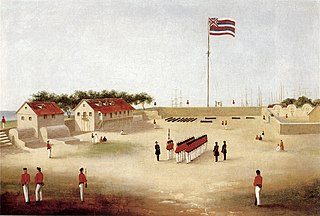
The French invasion of Honolulu was an attack on Honolulu, capital of the Hawaiian Kingdom, by French admiral Louis Tromelin in 1849 in retribution for the local persecution of Catholics and repression of French trade.

Hawaii–Tahiti relations refers to the historical relationship between the independent Hawaiian Kingdom and the Kingdom of Tahiti. Relations included one treaty, proposed marriage alliances and exchanges of trade and diplomatic representatives from the early 1800s to 1880.
Zepherin "Kepelino" Kahōʻāliʻi Keauokalani was a Native Hawaiian cultural historian who wrote Kepelino's Traditions of Hawaii. Born into a family descended from both the Hawaiian priestly class and nobility, Kepelino converted to Roman Catholicism with his family at an early age. He was educated by Catholic missionaries and briefly joined the mission to Tahiti before returning to finish his education in Honolulu. He became an editor of a Hawaiian language newspaper for Hawaiian Catholics and contributed many written works to the history and culture of Hawaii. Serving as a private secretary to Queen Emma of Hawaii, he espoused her candidacy for the throne in the 1874 monarchical election against Kalākaua. After the queen's loss in the election and Kalākaua's accession to the throne, Kepelino became involved in an attempt to overthrow the new king in favor of Queen Emma, which led to his trial and imprisonment for treason.
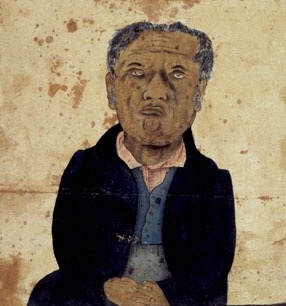
Bartimeus Lalana Puaʻaiki was an early convert and the first Native Hawaiian to be licensed to preach Protestant Christianity. Prior to his conversion, he served as a hula dancer in the court of King Kamehameha II and Queen Kamāmalu.

Hawaiian Independence Day was a national holiday celebrated annually on November 28 to commemorate the signing of Anglo-Franco Proclamation of 1843, the official diplomatic recognition of the independence and sovereignty of the Hawaiian Kingdom by Great Britain and France. It is still celebrated today by proponents of the Hawaiian sovereignty movement.
